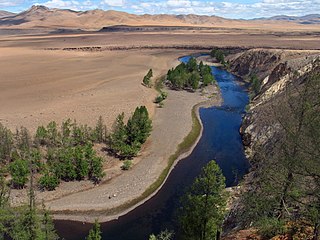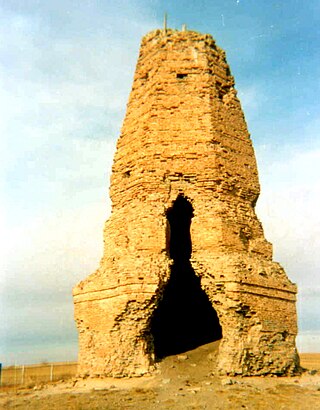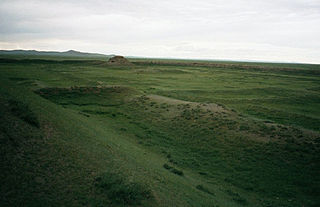This is a List of historical cities and towns of Mongolia. Mongolia is a landlocked country in East and Central Asia. It is bordered by Russia to the north and China to the south, east and west. Ulaanbaatar, the capital and largest city, is home to about 45% of the population.
"Mongolian cities" means those cities that were built in Mongolia as well those built in areas directly under Mongol influence. The special characteristic of Mongolian historical cities is that they came into being amidst a predominantly nomadic society. It is a misunderstanding to assume that there were no cities in Mongolia, or that all of the people were entirely nomadic all through their history. Based on current research, Mongolia's tradition of cities goes back over 2000 years.
...

Ulaanbaatar, previously anglicized as Ulan Bator, is the capital and most populous city of Mongolia. It has a population of 1.6 million, and it is the coldest capital city in the world by average yearly temperature. The municipality is located in north central Mongolia at an elevation of about 1,300 metres (4,300 ft) in a valley on the Tuul River. The city was founded in 1639 as a nomadic Buddhist monastic centre, changing location 28 times, and was permanently settled at its modern location in 1778.
Articles related to Mongolia include:

The Orkhon River is a river in Mongolia.

The Bayankhongor Province or Bayanhongor Aimag is one of the 21 aimags (provinces) of Mongolia. It is located in the southwest of the country and, at 116,000 square kilometers, it is one of the largest aimags. The capital of the aimag shares the provincial name, Bayankhongor.

Dornod is the easternmost of the 21 aimags (provinces) of Mongolia. Its capital is Choibalsan.

Khovd, alternatively romanized as Khobhd, is one of the 21 aimags (provinces) of Mongolia, located in the west of the country. Its capital is also named Khovd. Khovd province is approximately 1,580 km from Ulaanbaatar, Mongolia's capital. It takes its name from the Khovd River, which is located in this province.

Orkhon Valley Cultural Landscape sprawls along the banks of the Orkhon River in Central Mongolia, some 320 km west from the capital Ulaanbaatar. It was inscribed by UNESCO in the World Heritage List as representing the development of nomadic pastoral traditions spanning more than two millennia. (See List of World Heritage Sites in Mongolia).

Karakorum was the capital of the Mongol Empire between 1235 and 1260 and of the Northern Yuan dynasty in the late 14th and 15th centuries. Its ruins lie in the northwestern corner of the Övörkhangai Province of modern-day Mongolia, near the present town of Kharkhorin and adjacent to the Erdene Zuu Monastery, which is likely the oldest surviving Buddhist monastery in Mongolia. They are in the upper part of the World Heritage Site Orkhon Valley.

Ordu-Baliq, also known as Mubalik and Karabalghasun, was the capital of the Uyghur Khaganate. It was built on the site of the former Göktürk imperial capital, 27 km north-to-northwest of the later Mongol capital, Karakorum. Its ruins are known as Kharbalgas in Mongolian, which means "black ruins". They form part of the Orkhon Valley Cultural Landscape World Heritage Site.
The Khangai Mountains form a range in central Mongolia, some 400 km (250 mi) west of Ulaanbaatar.

The Tuul River or Tula River is a river in central and northern Mongolia. Sacred to the Mongols, the Tuul is generally called the Hatan Tuul. It is 882.8 kilometres or 549 miles long and drains an area of 49,840 square kilometres or 19,240 square miles. The Secret History of the Mongols frequently mentions a "Black Forest of the Tuul River" where the palace of Ong Khan was located.

A district, is a second level administrative subdivision of Mongolia. The 21 provinces of Mongolia are divided into 330 sum.

Uliastai, also spelled Uliyasutai or Oulia-Sontai, and sometimes known as Javkhlant, is a city in Mongolia located in the western part of the country and 1,115 kilometres (693 mi) from the capital Ulaanbaatar. Uliastai is the capital of Zavkhan Province and was the 10th most populous city in the country with a population of 24,276. However, recent estimates have the city's population at 16,240 making it the 16th most populous city in Mongolia.

Kharkhorin is a town and sum (district) center in Övörkhangai Province in Mongolia. The sum population was 13,828 (1994), 13,964 (2000), and 14,765 (2017). The population of Kharkhorin town itself was 14,765 in 2017 and covered an area of 20.5 km2.

The Darkhad, Darqads, or Darhut (Mongolian for "Blacksmiths","Workmen" are a subgroup of Mongol people living mainly in northern Mongolia, in the Bayanzürkh, Ulaan-Uul, Renchinlkhümbe, Tsagaannuur sums of Khövsgöl Province; The Darkhad valley is named after them. The regional variant of Mongol language is the Darkhad dialect. In the 2000 census, 16,268 people identified themselves as Darkhad.

The architecture of Mongolia is largely based on traditional dwellings, such as the yurt and the tent. During the 16th and 17th centuries, lamaseries were built throughout the country as temples which were later enlarged to accommodate a growing number of worshipers. Mongolian architects designed their temples with six and twelve angles and pyramidal roofs approximating the yurt's round shape. Further expansion led to a quadratic shape in the design of the temples, with roofs in the shape of pole marquees. Trellis walls, roof poles and layers of felt were eventually replaced by stone, brick beams and planks.

The Winter Palace of the Bogd Khan, or the Bogd Khan Palace Museum, is a museum complex located in Ulaanbaatar, Mongolia. It was part of larger complex called the "Green Palace", an imperial residence of the eighth Jebtsundamba Khutughtu, who was later proclaimed Bogd Khan, or ruler of Mongolia. Alongside being the oldest museum, it is also considered as one with the biggest collection in Mongolia. The palace is the only one left from originally four residences of the Bogd Khan.
The history of Ulaanbaatar, the capital of Mongolia, dates to 1639 when it was first established as a moveable monastery.

The Green Palace is the imperial winter residence of the Bogd Khan, ruler of Mongolia, located in Ulaanbaatar. It was also called the "Green Temple of the River" due its location.